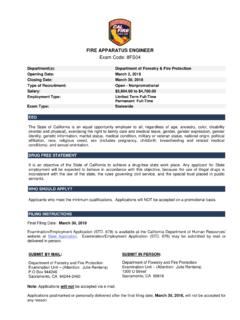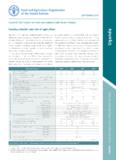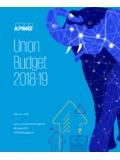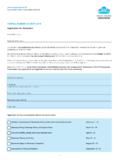Transcription of OECD Economic Surveys Ireland 2018
1 OECD Economic SurveysIrelandMarch 2018 Overview is extracted from the 2018 Economic Survey of Ireland . The Survey is published on the responsibility of the Economic and Development Review Committee of the OECD, which is charged with the examination of the Economic situation of member countries. The Economic situation and policies of Ireland were reviewed by the Committee on 18 January 2018 . The draft report was then revised in light of the discussions and given final approval as the agreed report of the whole Committee on 12 February 2018 . The Secretariat s draft report was prepared for the Committee by Ben Westmore and Yosuke Jin under the supervision of Pierre Beynet.
2 Statistical research assistance was provided by Paula Adamczyk and editorial assistance by Heloise Wickramanayake. The previous Survey of Ireland was issued in September about the latest as well as previous Surveys and more information about how Surveys are prepared is available at This document, as well as any data and any map included herein, are without prejudice to the status of or sovereignty over any territory, to the delimitation of international frontiers and boundaries and to the name of any territory, city or area. The statistical data for Israel are supplied by and under the responsibility of the relevant Israeli authorities.
3 The use of such data by the OECD is without prejudice to the status of the Golan Heights, East Jerusalem and Israeli settlements in the West Bank under the terms of international law. OECD Economic Surveys : Ireland OECD 2018 You can copy, download or print OECD content for your own use, and you can include excerpts from OECD publications, databases and multimedia products in your own documents, presentations, blogs, websites and teaching materials, provided that suitable acknowledgement of OECD as source and copyright owner is given. All requests for public or commercial use and translation rights should be submitted to Requests for permission to photocopy portions of this material for public or commercial use shall be addressed directly to the Copyright Clearance Center (CCC) at or the Centre fran ais d exploitation du droit de copie (CFC) at of or sovereignty over any territory, to the delimitation of international frontiers and boundaries and to the name of any territory, city or area.
4 EXECUTIVE SUMMARY 1 OECD Economic Surveys Ireland 2018 OECD 2018 Executive summary Economic prospects are good but clouded with uncertainty Reviving productivity is the key for future output and labour earnings2 EXECUTIVE SUMMARYOECD Economic Surveys Ireland 2018 OECD 2018 Living standards are high in Ireland , with recent improvements underpinned by the strongest post-crisis output recovery in the OECD. The Irish economy has demonstrated impressive durability over the past three decades. Average wages are now comparable with the top tier of OECD countries and income inequality is reduced through the highly redistributive tax and transfer system.
5 At the same time, the population report a high level of work-life balance, feel safe in public spaces and have strong social connections. The robust Economic recovery has now broadened to domestic demand. Irish export performance has displayed a sustained improvement and business investment by local firms is now recovering strongly, particularly in the construction sector. Household consumption has also been revived, aided by cuts in direct household taxes, strong employment growth and modest import price inflation. The unemployment rate has declined rapidly (Figure A), leading to a pick-up in wage growth in some sectors.
6 Figure A. The economy has recovered strongly Source: OECD Economic Outlook: Statistics and Projections (database); Central Statistics Office. StatLink2 The economy is projected to continue expanding over the next two years, albeit at a more sustainable pace. The labour market will tighten further, with the unemployment rate projected to fall to around 5 per cent. This will place further upward pressure on wages and inflation, with consumer prices expected to rise by over 2% in 2019. As real disposable income growth weakens, household consumption growth will also slow.
7 Private construction activity will continue to be spurred by rising property prices, but equipment and machinery investment is likely to be held back by increasing uncertainty in the business sector. GDP growth is expected to be around 2 per cent in 2019 (Figure B). Figure B. The economy will continue to expand at a solid pace Source: OECD Economic Outlook..but prospects are clouded with uncertaintyBrexit is a serious risk to the Economic outlook. OECD estimates show that a trade arrangement between the UK and EU governed by the World Trade Organisation s Most-Favoured Nation Rules could reduce total Irish exports by 20% in some sectors such as agriculture and food.
8 Given the large share of multinational firms in the Irish economy, an additional risk to the outlook is rising international tax competition. Heightened uncertainty makes it vital to further improve the fiscal position. Public finances have improved noticeably, but government debt remains high and tax receipts have become more subject to volatility (Figure C). Further public debt reduction would create scope for budgetary policy to support the economy in the event of a negative shock. This could be achieved through broadening the tax base in a way that does not significantly reduce medium-term growth.
9 For example, while ensuring that social inclusiveness is maintained, VAT preferential rates and exemptions could be eliminated and the property tax yield raised through more regular revaluations of the base. -16-12-8-404812162024-8-6-4-202468101220 0620072008200920102011201220132014201520 16201720182019 Gross value added excl. MNE-dominatedsectors (lhs)Unemployment rate (rhs)y-o-y% changes%201720182019 Gross domestic product (GDP) Private Government Gross fixed capital value added (exc. MNEs) price conditions are EXECUTIVE SUMMARY 3 OECD Economic Surveys Ireland 2018 OECD 2018 Figure C. Gross government debt ratios are declining but remain high Source: Central Statistics Office and OECD.
10 StatLink2 Vulnerabilities in the financial sector also need to be further addressed. While non-performing loans on bank balance sheets have declined by around 60% from their peak, the stock remains high (Figure D). This reflects judicial inefficiencies relating to the repossession of collateral and limited progress in improving the regulatory framework for writing-off NPLs. Measures that address these weaknesses, such as introducing stronger incentives for banks to reduce NPLs, will promote the efficient allocation of capital as well as the resilience of the economy overall.

















